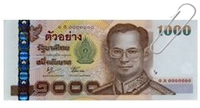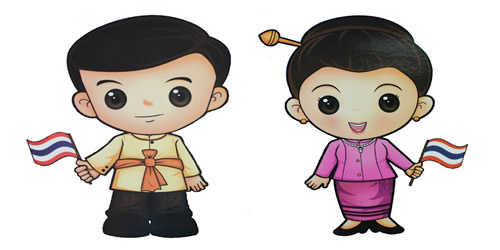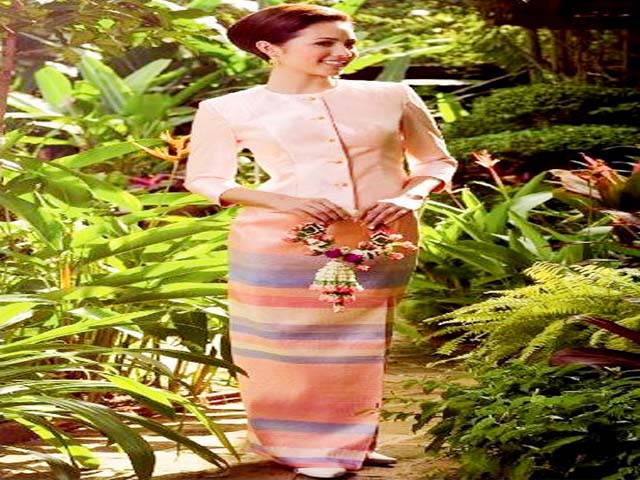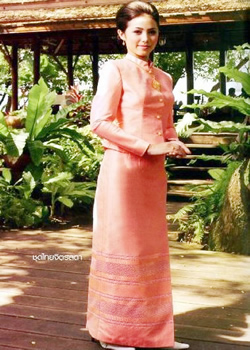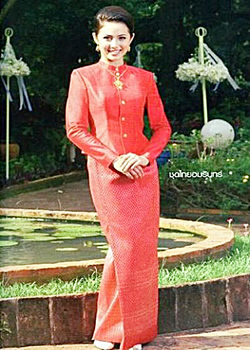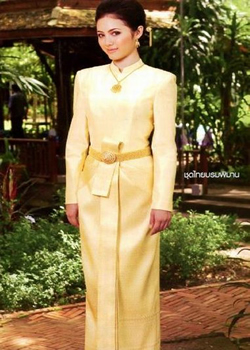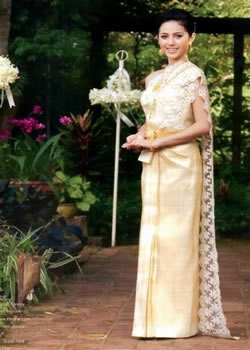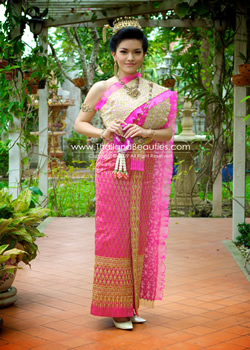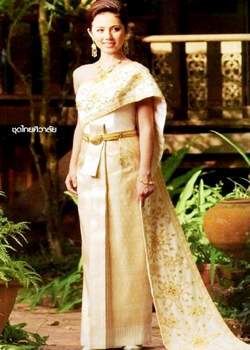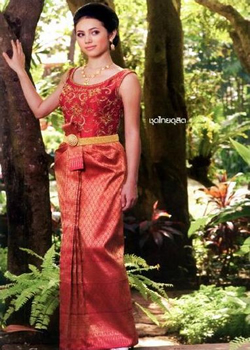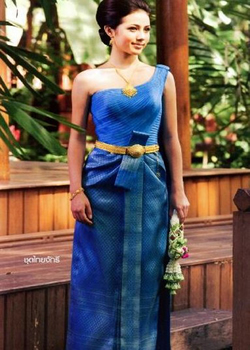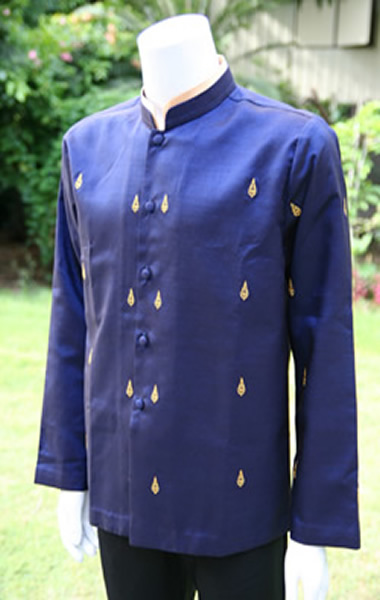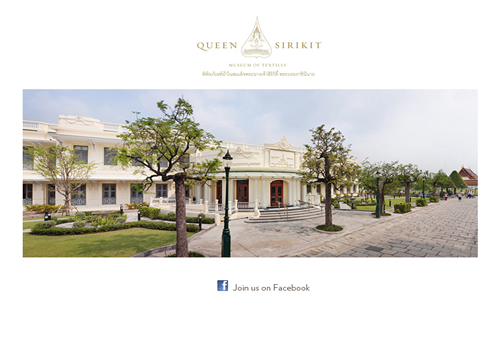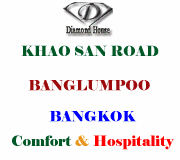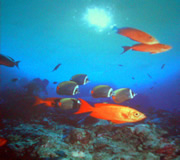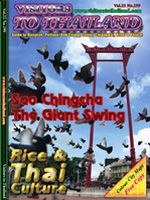
Brought to you by VISITORS TO THAILAND, Visitors to Koh Chang MAGAZINES
and MAPS
|
Thai National Costumes
When Queen Sirikit accompanied by the King Bhumibhol Adolyadej in state visits to Europe and the United States in 1960, H. M. noted that there was a need for a modern national costume suitable for formal wear. The queen had researched and conducted data from historical records of royal dresses, and eight official designs were developed and promoted by the queen herself and her aides. There are named Ruean Ton, Chit Lada, Amarin, Borom Bhiman, Chakkri, Dusit, Chakkrabhat and Siwalai Thai dresses accordingly. Since then, these dresses have been coming into the regular use by women for ever. The last one attire we are presented and recommended for Visitors to Thailand to praise that is Thai Payook Dress. However, men's national costume is known as 'suea bhraratcha-than (royally bestowed shirt).
Thai Chit Lada, with its brocaded band at the hem of the Bha Sin (sarong), is a daytime ceremonial dress. It is able to wear with a long sleeved blouse, with the front opening attached by five ornamental silver or golden buttons. Bha Sin (sarong) is a casual wraparound. It can be worn to an informal ceremony such as welcoming the official royal guests at the airport. Wearers do not need to decorate insignia but the color and style should be appropriate for situation. Courtesy picture of Thaiall.com
Thai Amarin is evening attire, made of brocaded fabric. This style, wearers do not need to wear belts. The blouse can be wide and round-necked. The sleeves length sits just below the elbows. The beauty of this dress is its textile and accessories. It is able to dress for dinner or importantly the Royal Birthday Procession. The royal decorations (insignia) are necessary to be worn. Courtesy picture of Thaiall.com
Thai Borom Bhiman is also a formal evening attire, comprising a long sleeved blouse which is either buttoned at the front or back. The blouse is tucked beneath Bha Sin (sarong) with its front pleats (Na Nang). The fabric is brocaded to create a highly luxurious appearance and impression. Her collar is round-necked style. The skirt (sarong) length runs about the ankle. Both Bha Sin and blouse are sewn together like a one piece dress of which style is suitable for a tall and slender person. It is able to wear in either formal or semi-formal events such as the League Ceremony or royal functions. This dress is necessary for decorating with royal accessories (insignia). Courtesy picture of Thaiall.com
Thai Chakkri is a formal and elegant out fits. Normally, the procession of weaving cloth, we are called "Yok" [ pronounced like: soak ] is a special technique. (Yok creates additional thickness within the fabric without adding supplementary threads. Often a touch of gold or silver-colored threads are added, making this procession of fabric is more expensive) Costume is finished with Bha Sin (sarong), a full length-round skirt with two pleats folds in the front called "Na Nang". Courtesy picture of Thaiall.com
Thai Chakkrabhat is Thai dress with a shawl like Thai Chakkri. However, it is more conservative and considered more official. The upper part has a pleated shawl cover, a thicker shawl with full embroidery on the upper shawl. It can be worn for royal or national ceremonies. Courtesy picture of ThailandBeauties.com
This costume is modified from Thai Chakkri dress. The method of cutting is like (traditional Thai) nun sleeve. It is pleated and leaving the edging of piece long and are sewn together like a one piece dress. Bha Sin or sarong is traditional Thai designs and decorated with front pleats (Na Nang) and also traditional Thai belt. It is very popular in the night clubs or celebration of marriage. Courtesy picture of Thaiall.com
Thai men's national costume is known as suea bhraratcha-than (royally bestowed shirt). It was designed to serve as a national costume by royal tailors-- Chupat Chuto, Phichai Watsanasong and Sompop Louilarpprasert for king Bhumibhol Adolyadej in 1979, and was subsequently given to promote and wear in public. It has been adopted by many, especially politicians and civil officials, on special occasions. Many will adopt the shirt for ceremonies such as their own weddings. The shirt shares the appearance of the raj pattern jacket, which itself is an older widely adopted (in Thailand) version of the Nehru jacket. Suea bhraratcha-than is specified as having a standing (Mandarin) collar 3.5 to 4 centimetres high, being slightly tapered at the sides, hemmed at the edges of the collar. Placket and sleeves are decorated with 5 round flat buttons which covered with a material identical or similar to that of the shirt. It should have two outer pockets at the front, at a level slightly higher than the lowermost button, may have a left-sided breast pocket, and may either be vented or not. The shirt comes in three varieties: short-sleeved, long-sleeved and lastly a long-sleeved with a sash, which range from the least to most formal, respectively. The long-sleeved versions should have 4 to 5 centimeters-wide cuffs of the same material as the shirt, and the sash, when used, should be knotted at the left side. The shirt is worn with trousers as would be with a suit jacket. Courtesy picture of mall.tard.com For more information do visit Queen Sirikit Museum of Textiles. It displays on Ratsadakornbhibhat House that located in the Grand Palace, Bangkok between the door of Wiman-thewet and Wiset-chaisri. Open daily from 09.00 a.m. to 04.30 p.m. Tickets were off at 03:30 p.m. from Wednesday, 9 May 2012 onwards. Admission fee for Thai adults are 150 baht, students 50 baht, children 12 to 18 years 50 baht, children under 12 years are free of charge. Please do dress properly (Do not wear shorts). Visitors to Thailand come from abroad please call for more details at 0 2225 9420, 0 2225 9430. |
|
“VISITORS TO THAILAND”
MAGAZINE and
MAPS GROUP is published monthly the tourist magazines and maps which
managed by
S.K. ADVERTISING. Feel free to E-mail us to request the latest copies of magazine
and maps. JustClick
©
since 2009 S.K.ADVERTISING.
visitorstothailand.com.
All Rights
Reserved.
41/1 Moo1 Soi Inroong Sukhapibal Road, Bangsrimuang sub district, Muang Nonthaburi district,
Nonthaburi 11000, Thailand.
Telephones: +662 447 4915 Fax: +662 882 7474
firstpage | hotels | maps | embassies | airlines | seas | dining | journey | about us | eMAGAZINE
